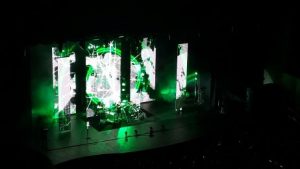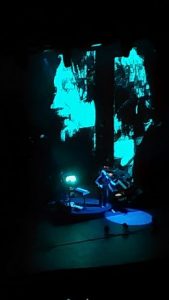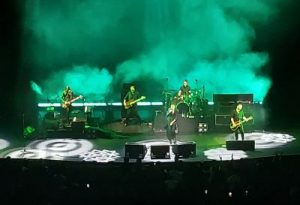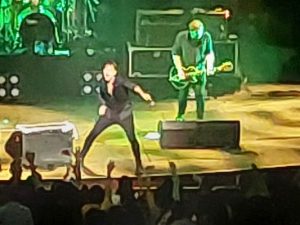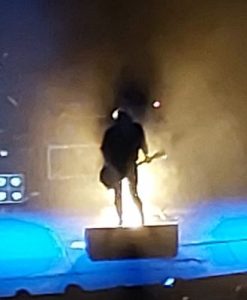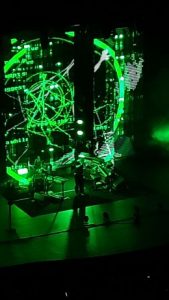
I don’t know when I became a fan of the band Radiohead. They seemed to creep up on me by stealth. I’d been aware of them for years before suddenly, one day, I realised: “Hey! I really like them!”
Appropriately for a band who crept up on me, the first song by them I heard was Creep from their debut album Pablo Honey (1993). Though a massive hit, I didn’t actually like Creep, finding it dull and plodding. My disdain for it was shared by Radiohead themselves, with guitarist Ed O’Brien saying of their performances of the song during the early 1990s: “We seemed to be living out the same four and a half minutes of our lives over and over again. It was incredibly stultifying.”
At this time I worked as a university lecturer in the northern Japanese city of Sapporo. One day in 1995 I received a gift from a cool indie-kid in one of my classes, Yoko Koyama, who’d discovered that despite my outward veneer of grumpiness and grouchiness I was, underneath, a sensitive soul who was heavily into music. The gift was a cassette recording of Radiohead’s newly-released second album, The Bends. I diplomatically accepted it, not expecting to like it much on the basis that I hadn’t been impressed by Creep. But when I listened to it, I thought, “This is actually pretty good.” Not brilliantly good, but definitely good.
Around then, Radiohead visited Sapporo and played a gig, but the night of their concert was one when I had to teach a couple of evening classes at the university. So I missed the chance to see them. The next day, I went into one of my regular Sapporo drinking hangouts, the Beifu-tei Bar, and got talking to a mate of mine, a Scotsman from St Andrews called Stevie Malcolm. Stevie informed me, “Aye, thon English rock band were in here last night after their gig. What dae ye call them? Thingmie-heid.”
“You mean, Radiohead?”
“Aye, Radio-heid!”
I got the impression Stevie had chatted away to Radiohead barely knowing who they were. Though from the band’s unconventional approach to the music industry and their discomfort with the trappings of superstardom, they probably liked chatting to strangers in bars with barely any idea of who they were.
In 1997 Radiohead released their third album OK Computer, which even my snobbiest, most purist music-loving friends, who’d dismissed Pablo Honey and The Bends with a contemptuous flick of the hand, had to admit was an awesome record. It still figures prominently when music publications list the best rock albums of all time and retrospective reviews frequently award it a full five stars. And though subsequent albums – Kid A (2000), Amnesiac (2001), Hail to the Thief (2003), In Rainbows (2007), The King of Limbs (2011) and A Moon Shaped Pool (2016) – never created quite the same stir, and often made demands on the listener by veering off into the avantgarde, experimental and left-field, I’ve found all of them laudable.
It helped that, unlike other bands who at various times were massively loved by audiences and hailed by critics as world-straddling musical colossi, Radiohead never seemed in your face that much. So you didn’t grow sick of them. Whereas for a few years U2 or Oasis, or even REM, seemed to be everywhere in the media, with the result that their ubiquity led to a backlash – the public losing interest, the critics getting disenchanted, familiarity generally breeding contempt – Radiohead were more subtle, less intrusive and lower profile. Perhaps their credibility endured because of that.
Even their appearances in popular culture tended to be wry and quirky and happened in unexpected, and cool, places. For example, I remember the very last episode of Father Ted (1995-98) when the suicidal priest Father Kevin (Tommy Tiernan) gets cured of his depression by Ted playing to him Isaac Hayes’ joyous Theme from Shaft (1971) – only to lapse back into suicidal depression when he hears Radiohead’s Exit Music (For a Film) (1997) playing on the radio in a bus. Or when they turned up in a 2001 episode of South Park called Scott Tenorman Must Die and added a final layer of torment to the unfortunate Scott Tenorman of the title. Scott is a kid who’s been tricked by Eric Cartman into eating the minced bodies of his dead parents. When he discovers what he’s done, he understandably bursts into tears. Just then, his favourite band, Radiohead, happen to stroll past, see him and cruelly mock him for being a ‘cry-baby’.
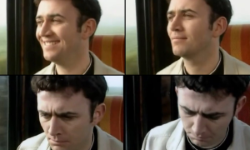
From x.com / © Hat Trick Productions
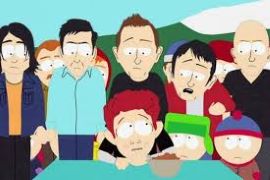
© South Park Studios
Anyway, last week on November 5th, Radiohead’s vocalist and main songwriter Thom Yorke rolled up here in Singapore to play a solo concert as part of his Everything tour. Yorke has a long history of making music on his own, from his 2006 album The Eraser, through 2014’s Tomorrow’s Modern Boxes, to 2019’s ANIMA, and he’s also been involved in a couple of side-bands like Atoms for Peace and The Smile, so it’s not a surprise to find him performing without the rest of Radiohead. I attended the gig accompanied by my better half, Mrs Blood and Porridge, who wouldn’t have missed this occasion for the world. She’s such a dyed-in-the-wool Radiohead fan that the other day she even made our cat watch the video for 2016’s Burn the Witch on YouTube.
Yorke played at the Star Theatre, which I’ve visited a couple of times in the past. At previous gigs there, I was not greatly impressed by the crowd, many of whom seemed more interested in filming the event on their phones than getting into the excitement and vibe of the music itself. As I wrote a while ago about a Deep Purple concert: “Why remove yourself from the occasion and gaze zombie-like at tiny figures moving about a tiny stage on a tiny screen…? It’s also, needless to say, disrespectful of the performers onstage… Honestly, there were times when the auditorium was so densely flecked with glowing phone-screens you felt you were flying over Las Vegas at night.” But tonight’s audience, Singaporeans and foreigners alike, seemed to be genuine Radiohead fans and Thom Yorke-lovers who knew the great man wasn’t going to appreciate having a thousand phones pointed at him by a thousand glaikit dimwits. So, thankfully, phone-usage was at a minimum.
It wasn’t the most physical of performances. Yorke spent most of his time on a patch of stage encircled by musical equipment, including several keyboards, and looked like a cross between Rick Wakeman of Yes and Captain Nemo tinkling out Sebastian Bach’s Toccata and Fugue in D Minor on his organ. He did, occasionally, venture towards the audience to play guitar or indulge in some shuffling dancing. The latter drew affectionate cheers. I have to say seeing Thom make his funky moves brought a smile to my face, as it seemed to prove there was at least one person on the planet whose dancing is even worse than mine is.
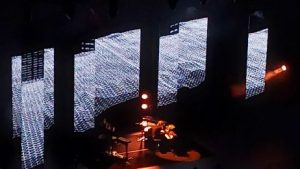
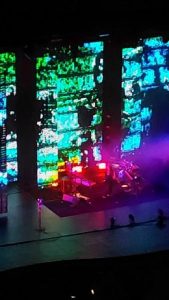
But what of the music? I’d read a worrying review of a gig from earlier in the tour, in Sydney, where the writer observed, “Each Radiohead song that’s played – they make up just under half the setlist – is met with a hushed reverence, while loud chatter is heard every time something else gets an airing.” Maybe that means modern-day Sydney concertgoers are disrespectful bozos, for that certainly wasn’t my impression of the Singapore crowd. Yes, the ten Radiohead numbers he played during the set – coming from a range of the band’s albums, though nothing featured from Pablo Honey, Hail to the Thief or The King of Limbs – were enthusiastically received. But the audience showed their appreciation of the non-Radiohead stuff as well. This included material from all three of Yorke’s solo albums, two new songs (Back in the Game and Hearing Damage), and two he’d composed for the 2018 soundtrack for Luca Guadagnino’s remake of the Dario Argento 1977 horror classic Suspiria.
It all meshed together nicely. The solo material evoked at different times the sounds of the Aphex Twin, Depeche Mode and Nine Inch Nails and I even wondered if Yorke was getting a bit disco-y at one or two points. Naturally, electronica-rooted Radiohead numbers like Idioteque, Everything in its Right Place or Packt Like Sardines in a Crushd Tin Box (off Kid A) slotted in seamlessly among that lot. Surprisingly, though, the band’s more conventional – dare I say more tuneful – songs, like How to Disappear Completely (Kid A again) Fake Plastic Trees (off The Bends), and All I Need (off In Rainbows) fitted in smoothly too, making it an impressively cohesive set. Maybe it was because Yorke’s falsetto – often mocked, but inimitable, haunting and gorgeous – provided the aural thread that stitched together all these disparate pieces of musical cloth.
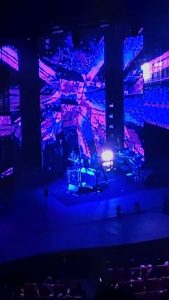
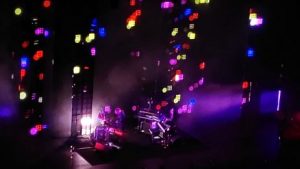
Praise is due too for the accompanying light show, with several tall screens treating the audience to dazzling and dizzying displays that, during the evening, seemed to range from daubs of luminous green graffiti to blizzards of multicoloured confetti, from drizzles of Matrix-style code to what looked like, frankly, masses of glowing spaghetti. Occasionally, these gave way to stark white light, and darkness, where, at his consoles, Yorke looked like a torturer operating his torture-machines in a gothic dungeon. Occasionally too, the chaotic patterns coalesced into the ghostly features of the man himself. Thus, the show was an impressively visual as well as aural experience. I have to say it was easier on the eyes than the screens at the previous gig I’d been to at the Star Theatre, which’d subjected me to regular, unflinching close-ups of the 78-year-old visage of Deep Purple’s Ian Gillan.
By the concert’s end it seemed the many diehard fans in the crowd had got their money’s worth. Their frequent cries of “I love you, Thom!” had never lessened in enthusiasm while the 22-song set wound on. And presumably the guy who shouted, before the gig and behind us on the escalator while we rode up to the theatre’s entrance, “Please, Thom, don’t play Creep tonight!”, went home happy too.
A good evening, then. It certainly took our minds off the horror that was happening elsewhere on November 5th.
